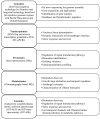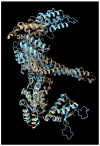OMICS and Other Advanced Technologies in Mycological Applications
- PMID: 37367624
- PMCID: PMC10302638
- DOI: 10.3390/jof9060688
OMICS and Other Advanced Technologies in Mycological Applications
Abstract
Fungi play many roles in different ecosystems. The precise identification of fungi is important in different aspects. Historically, they were identified based on morphological characteristics, but technological advancements such as polymerase chain reaction (PCR) and DNA sequencing now enable more accurate identification and taxonomy, and higher-level classifications. However, some species, referred to as "dark taxa", lack distinct physical features that makes their identification challenging. High-throughput sequencing and metagenomics of environmental samples provide a solution to identifying new lineages of fungi. This paper discusses different approaches to taxonomy, including PCR amplification and sequencing of rDNA, multi-loci phylogenetic analyses, and the importance of various omics (large-scale molecular) techniques for understanding fungal applications. The use of proteomics, transcriptomics, metatranscriptomics, metabolomics, and interactomics provides a comprehensive understanding of fungi. These advanced technologies are critical for expanding the knowledge of the Kingdom of Fungi, including its impact on food safety and security, edible mushrooms foodomics, fungal secondary metabolites, mycotoxin-producing fungi, and biomedical and therapeutic applications, including antifungal drugs and drug resistance, and fungal omics data for novel drug development. The paper also highlights the importance of exploring fungi from extreme environments and understudied areas to identify novel lineages in the fungal dark taxa.
Keywords: dark taxa; fungal metabolites; fungal taxonomy; high-throughput sequencing; multiomics approaches; phylogenetic analysis.
Conflict of interest statement
All authors declare that they have no conflict of interest.
Figures



References
-
- Kendrick B. The Fifth Kingdom. Focus Publishing; Sydney, NSW, Australia: 2000.
-
- Watkinson S.C., Boddy L., Money N. The Fungi. Academic Press; Cambridge, MA, USA: 2015.
-
- Hyde K.D., Norphanphoun C., Chen J., Dissanayake A.J., Doilom M., Hongsanan S., Jayawardena R.S., Jeewon R., Perera R.H., Thongbai B., et al. Thailand’s Amazing Diversity: Up to 96% of Fungi in Northern Thailand May Be Novel. Fungal Divers. 2018;93:215–239. doi: 10.1007/s13225-018-0415-7. - DOI
-
- Ellis M.B. Dematiaceous Hyphomycetes. Commonwealth Mycological Institute; Kew, Australia: 1971.
-
- Sutton B.C. The Coelomycetes. Fungi Imperfecti with Pycnidia, Acervuli and Stromata. Commonwealth Mycological Institute; Kew, Australia: 1980.
Publication types
Grants and funding
LinkOut - more resources
Full Text Sources

